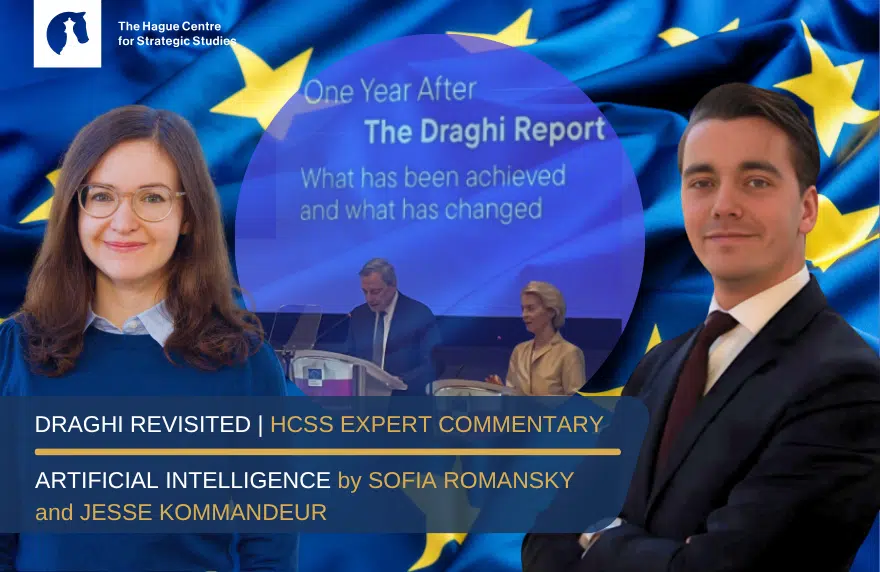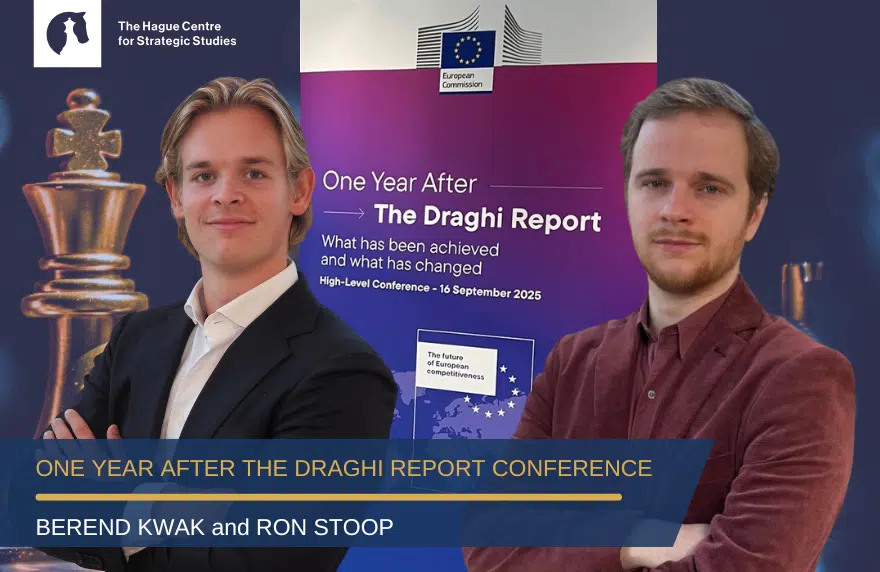One year after Mario Draghi’s landmark report on Europe’s economic future, HCSS launches the second edition of its Draghi Report Series, where our analysts revisit Draghi’s warnings sector by sector.
Despite political attention, Europe still struggles with dependencies in defence, raw materials, cleantech, and digital domains. Global tensions with both China and the US are mounting, and Europe’s trade model faces unprecedented pressure. Progress has been uneven and often too slow due to coordination, financing and other internal barriers.
Last year, Ron Stoop and Berend Kwak examined the long-term implications of Draghi’s recommendations in a series of interviews with our experts. Now, they return to assess how far Europe has come in addressing his urgent call to secure industrial, technological and economic sovereignty.
For the fourth article of our Draghi Report Revisited series, strategic analysts Sofia Romansky and Jesse Kommandeur takes a closer look at Europe’s progress on artificial intelligence.
Since the publication of the Draghi Report, what concrete steps have been taken at the EU and member state level around artificial intelligence, and how effective have they been so far?
Sofia Romansky: The Draghi Report emphasised the multiple risks of the European Union (EU) falling behind in strategic technologies, especially artificial intelligence (AI) and related software, hardware, and cloud components, due to insufficient investment and an inclination towards overregulation. AI is a strategic technology in two key dimensions: first, as a rapidly expanding market in its own right; and second, through its capacity to enhance efficiency across a broad range of industrial and service sectors. These dual aspects underpin the priority that has been accorded to AI as a category of technologies within the EU’s overarching competitiveness agenda.
While the EU AI Act remains a legislative cornerstone, the publication of the AI Continent Action Plan by the European Commission in April 2025 marks a decisive shift from a primarily regulatory to a more growth-oriented approach. The Plan identifies investment, infrastructure, and skills development as the essential pillars of Europe’s envisioned leadership in AI. Its centrepiece, InvestAI, is a financial initiative which aims to mobilize €200 billion in combined public and private investment. Furthermore, the Action Plan outlines mechanisms for the establishment of at least 15 operational AI Factories across 17 member states during 2025–2026, designed to consolidate and productively direct the costly resources which are needed to facilitate sophisticated AI computing and data infrastructure. These facilities are expected to act as regional hubs for research, innovation, and the commercialisation of AI, strengthening Europe’s global position. Complementary initiatives, such as the Data Union Strategy and the expansion of Euro High-Performance Computing Joint Undertaking supercomputing capacity, further support this ambition. At the national level, a growing number of EU member states have introduced or revised their national AI strategies and roadmaps. Collectively, these developments suggest that the EU is pursuing an integrated and iterative approach to ensure both competitiveness and the safeguarding of values.
Jesse Kommandeur: Despite the renewed urgency in the EU’s AI initiatives, a gap remains between governmental ambition and industrial uptake. The EU and its member states have introduced many frameworks and policy tools, but the question is how these will translate into market outcomes. As of 2024, only about 13.5% of EU enterprises had adopted AI, showing Europe’s struggle to move from pilots to large-scale integration. The AI Continent Action Plan is beginning to deliver more concrete steps. Its strength lies in its focus on (1) skills, (2) research, and (3) diffusion. AI Factories and Data Labs aim to build capacity for AI development and testing, while new degree programmes seek to expand the talent base. Fellowship schemes, apprenticeships for women in tech, and digital skills competitions further support this ‘pipeline’.
At the same time, global developments in the AI race increase the urgency for Europe’s to act fast and decisively. AI capabilities are advancing at unprecedented speed: between 2023 and 2024, model performance on major performance benchmarks such as GPQA and SWE-bench surged by up to 67 percentage points (meaning performance has improved considerably), while the computational cost of achieving a GPT-3.5-level quality response fell more than 280-fold. These trends are making advanced AI systems cheaper, more efficient, and more embedded in daily life. The Apply AI Strategy, focused on accelerating sectoral deployment and strengthening public–private cooperation, will therefore be crucial. The challenge now is to ensure that “AI made in Europe” moves beyond research toward high-impact applications. Whether Europe succeeds will depend on how effectively it can convert its expanding knowledge base into innovation that is not only compliant, but commercially and strategically useful.
Where do the biggest gaps lie between political ambition and practical implementation, and why do they exist?
Sofia Romansky: Despite political momentum and an increasingly coherent strategic vision at the institutional level, key gaps exist between the EU’s ambition and adoption of AI. The most fundamental of these gaps stem from enduring structural constraints within the European economy and governance system, issues symptomatic of broader patterns in EU policy execution. The Single Market remains fragmented, with inconsistent national approaches to AI regulation, data governance, and public procurement limiting cross-border scalability and the diffusion of innovation. Technological dependence on non-EU providers of semiconductors, cloud infrastructure, and large-scale models further constrains the Union’s strategic autonomy. At the same time, AI uptake across European industry remains low, particularly due to insufficient data readiness, skills shortages, and uncertainty regarding tangible returns on investment.
These challenges are compounded by capacity gaps in national administrations and supervisory authorities, many of which lack the technical expertise necessary for effective enforcement of legislation found in the EU AI Act. This highlights a central truth: the barriers to AI adoption are not solely technical, but deeply human, relating to knowledge, risk tolerance, and institutional learning. Both public and private sectors face obstacles in change management, reflecting cautious organisational cultures and limited absorptive capacity for innovation. Yet, these same human and institutional characteristics also represent the EU’s potential comparative advantage. By pursuing a human-centric approach that embeds trust, safety, and accountability into AI design and governance, the Union may be able to advance a model of technological integration that is not only competitive, but also socially sustainable and normatively legitimate.
Jesse Kommandeur: Next to the momentum generated by the Draghi Report, the gap between ambition and implementation remains. While Europe has advanced its legislative and strategic frameworks, it continues to struggle with converting these into deployment of models and competitiveness. The most persistent constraint could lie in the fragmentation of the European innovation landscape. Meanwhile, Europe’s dependence on non-EU providers of semiconductors, cloud infrastructure, and top tier models undermines its strategic autonomy, being dependent on the more vertically integrated ecosystems of the United States and China.
In parallel, the pace of global AI development has laid these gaps bare. Over the past year, AI model performance has risen sharply, while computational costs have fallen by orders of magnitude, lowering barriers and accelerating adoption worldwide. Nearly 90% of frontier models now originate from private companies, primarily outside Europe, showcasing how innovation leadership has shifted from public research institutions to private ecosystems over time. Within Europe, however, adoption remains slow. Many national authorities still lack the technical expertise to implement the AI Act effectively. Yet these same human-centric attributes (Europe’s emphasis on trust, safety, and accountability) can evolve into an advantage if embedded pragmatically into practice. The task ahead is to transform principle into performance: to pair Europe’s ethical and institutional strengths with the speed, risk appetite, and technological capability to remain competitive.
Looking ahead, what should be the EU’s top two or three priorities to stay competitive, and where might it make sense to scale back?
Sofia Romansky: Looking ahead, the foremost priority of the EU should be the targeted and demand-driven deployment of AI within sectors where Europe already possesses comparative advantages and abundant industrial data resources, such as advanced manufacturing, renewable energy, and healthcare. Rather than pursuing the indiscriminate automation of work processes, the focus should rest on the augmentation of existing operations, using AI to solve clearly defined, high-impact problems across established value chains. Achieving this requires the expansion of experimental environments and regulatory sandboxes, where public institutions, industry, and academia can test and refine AI applications.
At the same time, sustained investment in education and training is critical, not only to cultivate a technologically literate and skilled workforce but also to build the regulatory and ethical expertise needed to oversee AI systems effectively across member states. Therefore, any considerations of investment should include support for research networks and university-industry partnerships to cultivate Europe’s human capital base. To maximise the benefits of such investment and effectively direct initially limited resources the Union should scale back symbolic or duplicative initiatives that promote “AI for AI’s sake” without demonstrable utility.
Jesse Kommandeur: To remain relevant, Europe must focus on sectors where deep expertise, reliable data, and regulatory credibility intersect. Rather than replicating frontier model development, investment should target applied AI: adaptive systems, trustworthy data infrastructures, and interoperable platforms that enhance our industrial resilience.
A second priority is to strengthen Europe’s innovation metabolism, the rate at which ideas move from conception to commercialisation. Europe’s unique strength lies in linking technology to societal purpose; embedding AI into climate adaptation, public health, and defence preparedness would demonstrate that alignment. At the same time, it would make sense to scale back fragmented or prestige-driven initiatives that spread resources too thinly. Global competition shows that capability, not capacity, defines success: the United States produced 40 notable AI models in 2024 to Europe’s three, yet the EU can still lead where trust, interoperability, and domain depth determine long-term value.
Yet the question remains to what extent these values will retain their relevance in a world where geopolitical competition is increasingly defined by power rather than norms, and where technological power itself is becoming an instrument of strategic influence. For Europe, maintaining credibility in such an environment will require demonstrating that its value-driven approach can also deliver technological capability and geopolitical weight, and that trust and accountability are not only constraints but can also be sources of resilience that might eventually contribute to autonomy.
If we meet again in a year, what single measurable outcome would convince you that Europe is on the right track in this sector?
Sofia Romansky: Something to pay attention to in the coming year to evaluate whether Europe is on the right track would be the successful establishment and operationalisation of the planned AI Factories across member states. Their completion and effective use would demonstrate not only the EU’s capacity to mobilise investment and infrastructure at scale, but also its ability to integrate research, innovation, and industrial application within a cohesive framework. As centres that combine data resources, computing capacity, skills development, and regulatory experimentation, functioning AI Factories would embody a holistic model of AI integration.
Jesse Kommandeur: If we meet again in a year, the clearest sign that Europe is on the right track would be that AI has become both a visible and trusted part of daily life, much as it already is in other economies. In the United States, for example, the number of FDA-approved AI-enabled medical devices rose from just six in 2015 to 223 in 2023, while autonomous mobility services such as Waymo now provide over 150,000 driverless rides every week. A similar uptake in Europe, seen in for example AI-assisted healthcare in France, autonomous transport pilots in Denmark and Germany, or AI-driven city management in European cities like Amsterdam and Barcelona would show that Europe is on the right track. Success would mean that ‘AI made in Europe’ is not only safe, but also improving how Europeans work, travel, and access services in their everyday lives.








